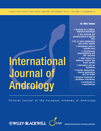Haemodynamic aspects of left-sided varicocele and its associaton with so-called right-sided varicocele
Abstract
A method has been developed which uses a radionucleotide to demonstate retrograde bloodflow in the testicular vein and the size of the pampiniform plexus in patients with a varicocele. This method and phlebography were both performed in 71 patients. The radionucleotide method was reliable in showing retrograde flow in the testicular vein and enabled quantification of the size of the pampiniform plexus. On the right side, however, retrograde bloodflow or an enlarged pampiniform plexus were not found in any of the 71 patients. Misinterpretation of phlebographic and radionucleotide studies are probably responsible for recent reports on the frequent occurrence of right sided varicocele.




